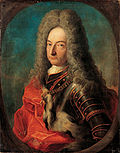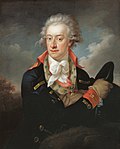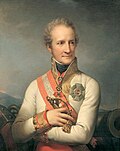| Name | Lifespan | Reign start | Reign end | Notes | Family | Image |
|---|
| Karl I | (1569-07-30)30 July 1569 – 12 February 1627(1627-02-12) (aged 57) | 20 December 1608 | 12 February 1627
(18 years, 54 days) | Son of Hartmann II | Liechtenstein |  |
| Karl Eusebius | (1611-04-11)11 April 1611 – 5 April 1684(1684-04-05) (aged 72) | 12 February 1627 | 5 April 1684
(57 years, 53 days) | Son of Karl I | Liechtenstein |  |
| Hans-Adam I | (1662-08-16)16 August 1662 – 16 June 1712(1712-06-16) (aged 49) | 5 April 1684 | 16 June 1712
(28 years, 72 days) | Son of Karl Eusebius | Liechtenstein |  |
Joseph Wenzel I
(1st reign) | (1696-08-09)9 August 1696 – 10 February 1772(1772-02-10) (aged 75) | 16 June 1712 | 12 March 1718
(5 years, 269 days) | Great-grandnephew of Karl I | Liechtenstein |  |
| Anton Florian | (1656-05-28)28 May 1656 – 11 October 1721(1721-10-11) (aged 65) | 12 March 1718 | 11 October 1721
(3 years, 213 days) | Uncle of Joseph Wenzel I | Liechtenstein |  |
| Joseph Johann Adam | (1690-05-25)25 May 1690 – 17 December 1732(1732-12-17) (aged 42) | 11 October 1721 | 17 December 1732
(11 years, 67 days) | Son of Anton Florian | Liechtenstein |  |
| Johann Nepomuk Karl | (1724-07-06)6 July 1724 – 22 December 1748(1748-12-22) (aged 24) | 17 December 1732 | 22 December 1748
(16 years, 5 days) | Son of Joseph Johann Adam | Liechtenstein |  |
Joseph Wenzel I
(2nd reign) | (1696-08-09)9 August 1696 – 10 February 1772(1772-02-10) (aged 75) | 22 December 1748 | 10 February 1772
(23 years, 50 days) | Great-grandnephew of Karl I | Liechtenstein |  |
| Franz Joseph I | (1726-11-19)19 November 1726 – 18 August 1781(1781-08-18) (aged 54) | 10 February 1772 | 18 August 1781
(9 years, 189 days) | Nephew of Joseph Wenzel I | Liechtenstein |  |
| Aloys I | (1759-05-14)14 May 1759 – 24 March 1805(1805-03-24) (aged 45) | 18 August 1781 | 24 March 1805
(23 years, 218 days) | Son of Franz Joseph I | Liechtenstein |  |
| Johann I Joseph | (1760-06-26)26 June 1760 – 20 April 1836(1836-04-20) (aged 75) | 24 March 1805 | 20 April 1836
(31 years, 27 days) | Son of Franz Joseph I | Liechtenstein |  |
| Aloys II | (1796-05-26)26 May 1796 – 12 November 1858(1858-11-12) (aged 62) | 20 April 1836 | 12 November 1858
(22 years, 206 days) | Son of Johann I Joseph | Liechtenstein |  |
| Johann II | (1840-10-05)5 October 1840 – 11 February 1929(1929-02-11) (aged 88) | 12 November 1858 | 11 February 1929
(70 years, 91 days) | Son of Aloys II | Liechtenstein |  |
| Franz I | (1853-08-28)28 August 1853 – 25 July 1938(1938-07-25) (aged 84) | 11 February 1929 | 25 July 1938
(9 years, 164 days) | Son of Aloys II | Liechtenstein |  |
| Franz Joseph II | (1906-08-16)16 August 1906 – 13 November 1989(1989-11-13) (aged 83) | 25 July 1938 | 13 November 1989
(51 years, 111 days) | Grand-nephew of Franz I | Liechtenstein |  |
| Hans-Adam II | (1945-02-14) 14 February 1945 (age 80) | 13 November 1989 | Incumbent
(36 years, 35 days) | Son of Franz Joseph II | Liechtenstein |  |















